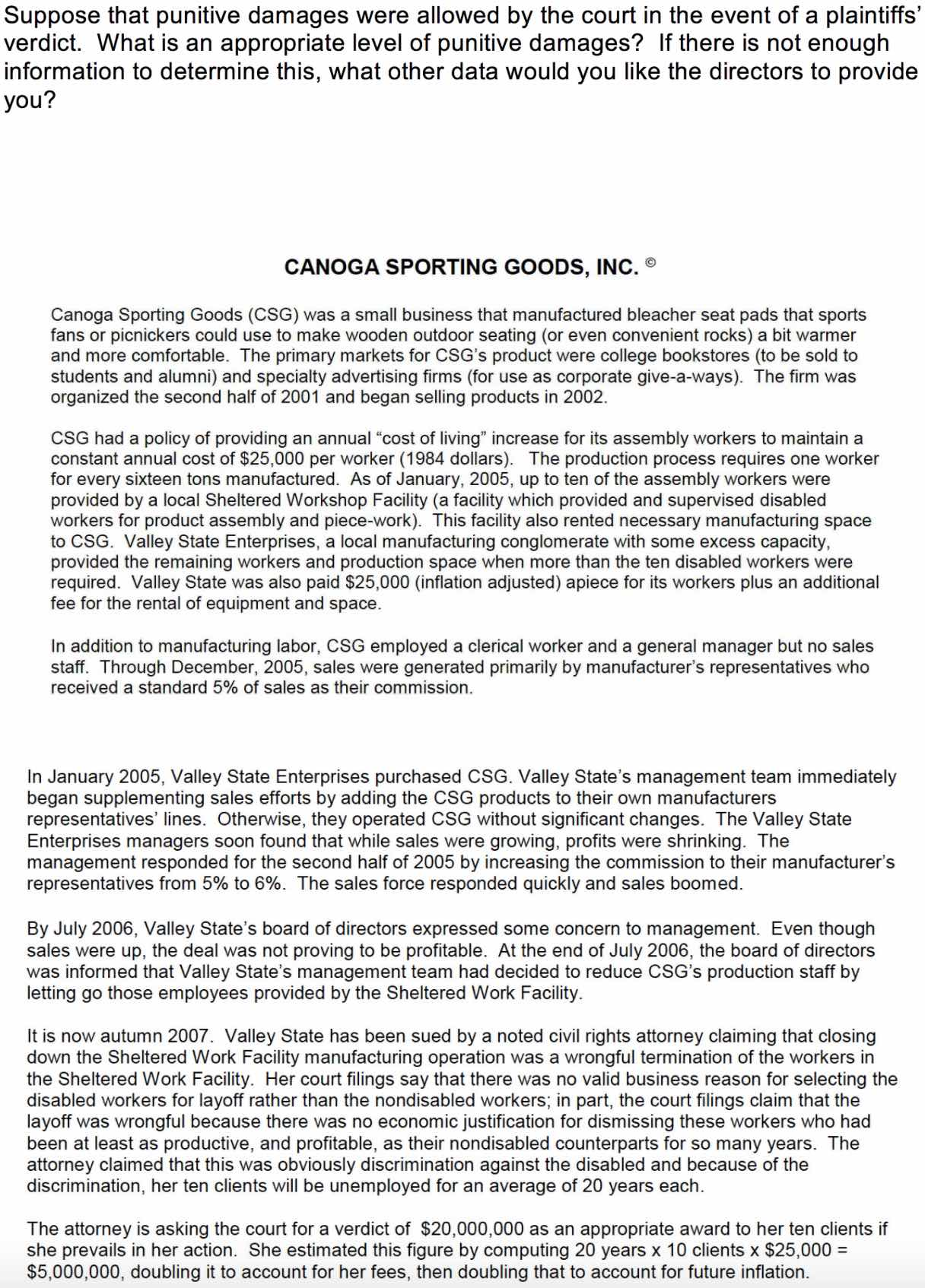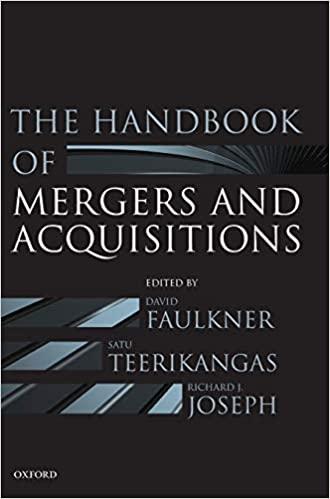Please read the following article and answer the following question:

Suppose that punitive damages were allowed by the court in the event of a plaintiffs' verdict. What is an appropriate level of punitive damages? If there is not enough information to determine this, what other data would you like the directors to provide you? CANOGA SPORTING GOODS, INC. Canoga Sporting Goods (CSG) was a small business that manufactured bleacher seat pads that sports fans or picnickers could use to make wooden outdoor seating (or even convenient rocks) a bit warmer and more comfortable. The primary markets for CSG's product were college bookstores (to be sold to students and alumni) and specialty advertising firms (for use as corporate give-a-ways). The firm was organized the second half of 2001 and began selling products in 2002. CSG had a policy of providing an annual "cost of living" increase for its assembly workers to maintain a constant annual cost of $25,000 per worker (1984 dollars). The production process requires one worker for every sixteen tons manufactured. As of January, 2005, up to ten of the assembly workers were provided by a local Sheltered Workshop Facility (a facility which provided and supervised disabled workers for product assembly and piece-work). This facility also rented necessary manufacturing space to CSG. Valley State Enterprises, a local manufacturing conglomerate with some excess capacity, provided the remaining workers and production space when more than the ten disabled workers were required. Valley State was also paid $25,000 (inflation adjusted) apiece for its workers plus an additional fee for the rental of equipment and space. In addition to manufacturing labor, CSG employed a clerical worker and a general manager but no sales staff. Through December, 2005, sales were generated primarily by manufacturer's representatives who received a standard 5% of sales as their commission. In January 2005, Valley State Enterprises purchased CSG. Valley State's management team immediately began supplementing sales efforts by adding the CSG products to their own manufacturers representatives' lines. Otherwise, they operated CSG without significant changes. The Valley State Enterprises managers soon found that while sales were growing, profits were shrinking. The management responded for the second half of 2005 by increasing the commission to their manufacturer's representatives from 5% to 6%. The sales force responded quickly and sales boomed. By July 2006, Valley State's board of directors expressed some concern to management. Even though sales were up, the deal was not proving to be profitable. At the end of July 2006, the board of directors was informed that Valley State's management team had decided to reduce CSG's production staff by letting go those employees provided by the Sheltered Work Facility. It is now autumn 2007. Valley State has been sued by a noted civil rights attorney claiming that closing down the Sheltered Work Facility manufacturing operation was a wrongful termination of the workers in the Sheltered Work Facility. Her court filings say that there was no valid business reason for selecting the disabled workers for layoff rather than the nondisabled workers; in part, the court filings claim that the layoff was wrongful because there was no economic justification for dismissing these workers who had been at least as productive, and profitable, as their nondisabled counterparts for so many years. The attorney claimed that this was obviously discrimination against the disabled and because of the discrimination, her ten clients will be unemployed for an average of 20 years each. The attorney is asking the court for a verdict of $20,000,000 as an appropriate award to her ten clients if she prevails in her action. She estimated this figure by computing 20 years times 10 clients times $25,000 = $5,000,000, doubling it to account for her fees, then doubling that to account for future inflation. Suppose that punitive damages were allowed by the court in the event of a plaintiffs' verdict. What is an appropriate level of punitive damages? If there is not enough information to determine this, what other data would you like the directors to provide you? CANOGA SPORTING GOODS, INC. Canoga Sporting Goods (CSG) was a small business that manufactured bleacher seat pads that sports fans or picnickers could use to make wooden outdoor seating (or even convenient rocks) a bit warmer and more comfortable. The primary markets for CSG's product were college bookstores (to be sold to students and alumni) and specialty advertising firms (for use as corporate give-a-ways). The firm was organized the second half of 2001 and began selling products in 2002. CSG had a policy of providing an annual "cost of living" increase for its assembly workers to maintain a constant annual cost of $25,000 per worker (1984 dollars). The production process requires one worker for every sixteen tons manufactured. As of January, 2005, up to ten of the assembly workers were provided by a local Sheltered Workshop Facility (a facility which provided and supervised disabled workers for product assembly and piece-work). This facility also rented necessary manufacturing space to CSG. Valley State Enterprises, a local manufacturing conglomerate with some excess capacity, provided the remaining workers and production space when more than the ten disabled workers were required. Valley State was also paid $25,000 (inflation adjusted) apiece for its workers plus an additional fee for the rental of equipment and space. In addition to manufacturing labor, CSG employed a clerical worker and a general manager but no sales staff. Through December, 2005, sales were generated primarily by manufacturer's representatives who received a standard 5% of sales as their commission. In January 2005, Valley State Enterprises purchased CSG. Valley State's management team immediately began supplementing sales efforts by adding the CSG products to their own manufacturers representatives' lines. Otherwise, they operated CSG without significant changes. The Valley State Enterprises managers soon found that while sales were growing, profits were shrinking. The management responded for the second half of 2005 by increasing the commission to their manufacturer's representatives from 5% to 6%. The sales force responded quickly and sales boomed. By July 2006, Valley State's board of directors expressed some concern to management. Even though sales were up, the deal was not proving to be profitable. At the end of July 2006, the board of directors was informed that Valley State's management team had decided to reduce CSG's production staff by letting go those employees provided by the Sheltered Work Facility. It is now autumn 2007. Valley State has been sued by a noted civil rights attorney claiming that closing down the Sheltered Work Facility manufacturing operation was a wrongful termination of the workers in the Sheltered Work Facility. Her court filings say that there was no valid business reason for selecting the disabled workers for layoff rather than the nondisabled workers; in part, the court filings claim that the layoff was wrongful because there was no economic justification for dismissing these workers who had been at least as productive, and profitable, as their nondisabled counterparts for so many years. The attorney claimed that this was obviously discrimination against the disabled and because of the discrimination, her ten clients will be unemployed for an average of 20 years each. The attorney is asking the court for a verdict of $20,000,000 as an appropriate award to her ten clients if she prevails in her action. She estimated this figure by computing 20 years times 10 clients times $25,000 = $5,000,000, doubling it to account for her fees, then doubling that to account for future inflation







